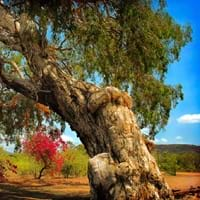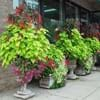What is
Life Span
Perennial
Annual
Type
Bulb or Corm or Tuber
Tree
Origin
South America
Southeastern Asia, Australia
Types
Pamianthe cardenasii , Pamianthe parviflora , Pamianthe peruviana
Not Available
Number of Varieties
3
99+
Not Available
Habitat
All sorts of environments
Warm and moist climatic conditions
USDA Hardiness Zone
8-10
9-15
AHS Heat Zone
10-8
12-7
Sunset Zone
21,22
H1, H2, 9, 12, 13, 15, 16, 17, 20, 21, 22, 23, 24
Habit
Clump-Forming
Upright/Erect
Information
Plant Size
Minimum Height
61.00 cm
99+
610.00 cm
99+
Minimum Width
61.00 cm
99+
610.00 cm
34
Plant Color
Flower Color
White
Light Yellow, Light Pink, Ivory
Flower Color Modifier
Bicolor
Bicolor
Fruit Color
Green
Sandy Brown
Leaf Color in Spring
Dark Green
Green, Dark Green
Leaf Color in Summer
Light Green
Dark Green
Leaf Color in Fall
Several shades of Green
Dark Green
Leaf Color in Winter
Light Green
Dark Green, Plum
Shape
Leaf Shape
Strap shaped
Elliptic
Thorns
No
No
Season
Plant Season
Spring, Summer, Fall
Spring, Summer, Fall, Winter
Growing Conditions
Sunlight
Partial Sun, Partial shade
Full Sun, Partial Sun
Growth Rate
Fast
Fast
Type of Soil
Loam, Sand
Clay, Loam, Sand
The pH of Soil
Acidic, Neutral, Alkaline
Acidic, Neutral, Alkaline
Soil Drainage
Average
Average
Bloom Time
Spring, Late Spring, Early Summer, Summer, Late Summer
Late Summer, Early Fall, Fall, Late Fall
Repeat Bloomer
No
Yes
Tolerances
Drought
Wet Site, Pollution, Drought, Soil Compaction
Care
Where to Plant?
Ground, Pot
Ground
How to Plant?
Offsets
Seedlings
Plant Maintenance
Medium
Medium
Watering Plants
Watering Requirements
Keep the ground moist but not water-logged
Get enough water whenever the soil is dry
In Summer
Lots of watering
Lots of watering
In Spring
Moderate
Moderate
In Winter
Average Water
Average Water
Soil
Soil pH
Acidic, Neutral, Alkaline
Acidic, Neutral, Alkaline
Soil Type
Loam, Sand
Clay, Loam, Sand
Soil Drainage Capacity
Average
Average
Sun Exposure
Partial Sun, Partial shade
Full Sun, Partial Sun
Pruning
Pinch or prune as they grow to promote branching and bushiness, Remove damaged leaves, Remove dead branches, Remove dead leaves, Requires little pruning
Remove damaged leaves, Remove dead branches, Remove dead leaves
Fertilizers
All-Purpose Liquid Fertilizer, High phosphorus
All-Purpose Liquid Fertilizer
Pests and Diseases
Leaf spot, Mosaic viruses
Red blotch
Plant Tolerance
Drought
Drought
Facts
Flowers
Showy
Showy
Flower Petal Number
Single
Single
Fruits
Showy Fruit
No
No
Edible Fruit
No
No
Fragrance
Fragrant Flower
No
Yes
Fragrant Fruit
No
No
Fragrant Leaf
No
Not Available
Fragrant Bark/Stem
No
Not Available
Showy Foliage
No
Yes
Showy Bark
No
Yes
Foliage Texture
Coarse
Fine
Foliage Sheen
Glossy
Matte
Evergreen
No
No
Invasive
No
Sometimes
Self-Sowing
Yes
Yes
Attracts
Bees, Birds, Bumblebees, Butterflies, Hummingbirds, pollinators
Birds, Hummingbirds
Allergy
Unknown
Not Available
Benefits
Uses
Aesthetic Uses
Beautification, Bouquets, Ornamental use, Showy Purposes
Showy Purposes
Beauty Benefits
Not Available
Not Available
Edible Uses
No
Yes
Environmental Uses
Air purification
Air purification
Plant Benefits
Medicinal Uses
Not Available
Antibiotic, Cough, Headache, hemorrhoids, Respiratory Disorders, Rheumatism
Part of Plant Used
Not Available
Bark, Flowers, Leaves, Wood
Other Uses
Beneficial species for attracting pollinators, Decoration Purposes
Used as essential oil
Used As Indoor Plant
No
No
Used As Outdoor Plant
Yes
Yes
Garden Design
Bog Garden, Container, Feature Plant, Foundation, Mixed Border, Water Gardens
Shade Trees, Street Trees, Tropical
Scientific Name
Botanical Name
HYMENOCALLIS longipetala
MELALEUCA quinquenervia
Common Name
Peruvian Daffodil, Spiderlily
Cajeput Tree, Paperbark Tree, Punk Tree
In Hindi
peruvian daffodil
Paperbark tree
In German
peruvian daffodil
Paperbark tree
In French
peruvian daffodil
Paperbark tree
In Spanish
Pamianthe
Paperbark tree
In Greek
peruvian daffodil
Paperbark tree
In Portuguese
peruvian daffodil
Paperbark tree
In Polish
peruvian daffodil
Paperbark tree
In Latin
peruvian daffodil
Paperbark tree
Classification
Kingdom
Plantae
Plantae
Phylum
Magnoliophyta
Magnoliophyta
Class
Liliopsida
Magnoliopsida
Order
Asparagales
Myrtales
Family
Amaryllidaceae
Myrtaceae
Genus
Pamianthe
Melaleuca
Clade
Angiosperms, Monocots
Angiosperms, Eudicots, Rosids
Tribe
Clinantheae
Not Available
Subfamily
Amaryllidoideae
Not Available
Number of Species
Not Available
Not Available
|
||
|
||
|












